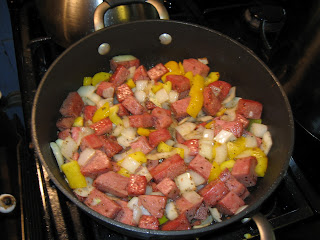Rum Raisin Ice Cream
This is my favorite ice cream. In Utah it is very rare to get this flavor at the local ice cream vendor. Clearly, the local religion did not have "rum raisin" as a flavor of choice for their children.
This is a very simple approach to the recipe. Take the best available vanilla ice cream, mix in rum-soaked raisins and refreeze. (In the photo above, I give credit to photographer Penny de los Santors for the most tasty of photos ever.) The rum-flavored fruitcakes made by my grandmother made me a fan of the rum raisin flavor. A bottle of Bundaberg Rum was the only alcoholic beverage in my grandparent's home, and it was kept in a dark, secret place in the pantry.
Ingredients

1 quart of raisins. The typical box of 24 oz. raisins is a little over a quart
1 cup of dark 70-proof rum
2 quarts of vanilla ice cream (French vanilla is my preference)
First, place the raisins and rum in a half-gallon canning jar and let the mixture sit for a week. I turn the bottle over every day to help the mixing process. Most of the rum will be absorbed by the raisins. If you do not want to wait for a week, adding a little more rum and letting the mixture sit overnight in a sealed container will work.
Place the raisins and ice cream in a bowl and mix wel as the ice cream starts to get soft. Do not let the ice cream melt completely. Place the mixture in a sealed bowl in the freezer. The rum raisin ice cream can be served next day.
Our favorite dessert: rum raisin ice cream and Gran's peanut cookies.
The Bundaberg Rum I remember from grandma's cooking has a long and interesting history. Some of my mother's relatives raised sugar cane close to the town of Bundaberg. My grand uncle, Horsley Pashly, owned a sugar cane farm near Bundaberg. I visited the farm on several occasions as a young teenager. Uncle Horsley took considerable time to explain sugar cane farming. He also introduced me to one of the strangest ecological disasters in Australian history, the cane toad.
The Australian Museum reported:
"The natural range of Cane Toads extends from the southern United States to tropical South America. They were deliberately introduced from Hawaii to Australia in 1935, to control scarab beetles that were pests of sugar cane. .....Cane Toads are considered a pest in Australia because they:
Poison pets and injure humans with their toxins; Poison many native animals whose diet includes frogs, tadpoles and frog's eggs; Eat large numbers of honey bees, creating a management problems for bee-keepers; Prey on native fauna; Compete for food with vertebrate insectivores such as small skinks; May carry diseases that can be transmitted to native frogs and fishes."
The sugar from the sugar cane was produced locally in the Bundaberg area and the byproduct was molasses, which was considered a waste product. In 1888, the local sugar producers combined their resources and started the Bundaberg Rum Distillery as a way to make money from the molasses. This new industry was a success. The patrons are often called "Bundy" drinkers. These patrons have a rowdy reputation in some circles. One recent Wikipedia observation stated:
"Bundaberg Rum has been labelled the drink for yobbos, after some bars reported that 'bundy drinkers are a lot louder, and more disruptive than other patrons.' In 2005, four bars in Brisbane banned the rum products, claiming it makes drinkers aggressive and attracts the wrong crowd."
"Yobbo" is Australian for the USA term "redneck."
Uncle Horsley died in 1982. In checking some of the facts on the Pashley family I came on the following news summary from July 1892. The following depressing series of events generates respect for the daily dangers our pioneers faced. The four-year-old Sydney Pashley was certainly a relative of Uncle Horsley, who was born in 1904.
Taken from The Queenslander: Saturday, July 30, 1892
Queensland News:
Herberton, July 26
"Michael HICKER, a stream tin miner, from Coolgar, left Herberton with his mate on Saturday evening on his way to camp, and when a short distance out on the Watsonville-road he was thrown from his horse, sustaining a fracture of the base of the skull. He was at once taken to the hospital, but died soon after admission.
Don't know where the following happened, paper damaged, in Qld though.
Mrs. Tremble, wife of a carter and wharf lumper, cut her throat this morning with a razor. She made two deep cuts into the wind-pipe, which bled profusely: and she is in a critical condition, owing to the blood suffusing the lungs. The cause of the attempted suicide was melancholy, arising from her being in an almost destitute condition, and a recent accident to one of her children."
------
Rockhampton: July 22,
"A young man named Richard SEALY, a son of ex-Constable SEALY, died last night from the effects of injuries received through a collision with another horseman at the racecourse on Thursday."
-------
Fatal Accidents at Bundaberg, July 25
"Two fatal accidents occurred on Saturday. A child named Sydney PASHLEY, 4 years old, was run over at North Bundaberg by a bullock dray, its head being severed from it's body.
At Fairymead a workman named Conrad RODEGER fell into a tank of boiling juice. He got himself out, but was fearfully burnt. He was removed to the Bundaberg Hospital, where he expired in fearful agony on Saturday afternoon.
Another fatal accident occurred to-day. A well known farmer named Joseph NEWELL, of Kalkall, was leading a horse which had been newly broken in to harness, when the horse bolted and threw him under the dray, the wheel of which passed over him, killing him instantly, his neck being broken."
--------------
The "tank of boiling juice" responsible for the death of Conrad Rodeger was almost certainly a part of the manufacturing of sugar from the sugar cane.















































